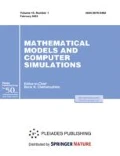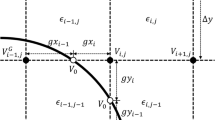Abstract
The paper considers methods and algorithms providing the basis for a computer program implementing an axial-symmetric electrostatic version of the particle-in-cell method on unstructured triangular grids. In the presented implementation, the Poisson equation is approximated using the finite volume method. A discrete analog of the Poisson equation is solved by the multigrid method. Charged particle trajectories are calculated using the Boris method. Methods for interpolating electrostatic fields on unstructured grids and obtaining the charge density in the computational domain are considered. Special attention is paid to the specifics of implementing these methods in axisymmetric geometry. The developed computer code is tested on the problem of a flat diode operating in the space charge mode.
Similar content being viewed by others
References
F. M. Penning, “Ein neues Manometer fur niedrige Gasdrucke, insbesondere zwischen 10-3 and 10-5 mm,” Physica 4, 71–75 (1937).
F. M. Penning and J. H. A. Moubis, “Eine Neutronenrohre ohne Pumpvorrichtung,” Physica 4, 1190–1199 (1937).
J. L. Rovey, B. P. Ruzic, and T. J. Houlahan, “Simple penning ion source for laboratory research and development applications,” Rev. Sci. Instrum. 78, 106101-1–106101-3 (2007).
J. L. Rovey, “Design parameter investigation of a cold-cathode penning ion source for general laboratory applications,” Plasma Sources Sci. Technol. 17, 035009-1–035009-7 (2008).
Yu. A. Berezin and V. A. Vshivkov, Particle-in-cell Method in Rarefied Plasma Dynamics (Nauka, Novosibirsk, 1980) [in Russian].
R. W. Hockney and J. W. Eastwood, Computer Simulation Using Particles (CRC, New York, 1987).
C. K. Birdsall and A. B. Langdon, Plasma Physics via Computer Simulation (McGraw-Hill, New York, 1985).
Yu. N. Grigoriev, V. A. Vshivkov, and M. P. Fedoruk, Numerical 'Particle-In-Cell’ Methods: Theory and Applications (VSP, Utrecht, Boston, 2002; Sib. Otdel. RAN, Novosibirsk, 2004).
Yu. P. Raizer and S. T. Surzhikov, “Magnetohydrodynamic description of collisionless plasma expansion in upper atmosphere,” AIAA J. 33, 486–490 (1995).
S. T. Surzhikov, “Expansion of multi-charged plasma clouds into ionospheric plasma with magnetic field,” AIAA Paper No. 97–2361 (AIAA, 1997).
S. T. Surzhikov, “Collisionless expansion of a plasma with doubly charged ions in a rarefied magnetized plasma,” Plasma Phys. Rep. 26, 759–771 (2000).
C. K. Birdsall, “Particle-in-cell charged-particle simulations, plus Monte Carlo collisions with neutral atoms, PIC-MCC,” IEEE Trans. Plasma Sci. 19, 65–85 (1991).
Z. Donko, “Particle simulation methods for studies of low-pressure plasma sources,” Plasma Sources Sci. Technol. 20, 024001(2011).
V. Vahedi and M. Surendra, “A Monte Carlo collision model for the particle in cell method: applications to argon and oxygen discharges,” Comput. Phys. Commun. 87, 179–198 (1995).
V. Vahedi, G. DiPeso, C. K. Birdsall, M. A. Lieberman, and T. D. Rognlien, “Capacitive RF discharge modelled by particle-in-cell Monte Carlo simulation. I: Analysis of numerical techniques,” Plasma Sources Sci. Technol. 2, 261–272 (1993).
V. Vahedi, C. K. Birdsall, M. A. Lieberman, G. DiPeso, and T. D. Rognlien, “Capacitive RF discharge modelled by particle-in-cell Monte Carlo simulation. II: Comparisons with laboratory measurements of electron energy distribution function,” Plasma Sources Sci. Technol. 2, 273–278 (1993).
H. Burau, R. Widera, W. Honig, G. Juckeland, A. Debus, T. Kluge, U. Schramm, T. E. Cowan, R. Sauerbrey, and M. Bussmann, “PIConGPU: a fully relativistic particle-in-cell code for a GPU cluster,” IEEE Trans. Plasma Sci. 38, 2831–2839 (2010).
I. A. Surmin, S. I. Bastrakov, E. S. Efimenko, A. A. Gonoskov, A. V. Korzhimanov, and I. B. Meyerov, “Particle-in-cell laser-plasma simulation on xeon phi coprocessors,” Comput. Phys. Commun. 202, 204–210 (2016).
M. Pfeiffer, A. Mirza, C.-D. Munz, and S. Fasoulas, “Two statistical particle split and merge methods for particle-in-cell codes,” Comput. Phys. Commun. 191, 9–24 (2015).
G. B. Jacobs and J. S. Hesthaven, “High-order nodal discontinuous Galerkin particle-in-cell method on unstructured grids,” J. Comput. Phys. 214, 96–121 (2006).
H. K. Versteeg and W. Malalasekera, An Introduction to Computational Fluid Dynamics, 2nd ed. (Pearson Education, Harlow, 2007).
R. P. Fedorenko, “A relaxation method for solving elliptic difference equations,” Zh. Vychisl. Mat. Mat. Fiz. 1, 922–927 (1961).
R. P. Fedorenko, “The speed of convergence of one iterative process,” Zh. Vychisl. Mat. Mat. Fiz. 4, 559–564 (1964).
D. J. Mavriplis, “Multigrid techniques for unstructured meshes,” Report NASA-CR-195070 (NASA, Hampton, 1995).
I. E. Sutherland and G. W. Hodgman, “Reentrant polygon clipping,” Commun. ACM 17, 32–42 (1974).
J. D. Ramshaw, “Conservative rezoning algorithm for generalized two-dimensional meshes,” J. Comput. Phys. 59, 193–199 (1985).
D. Elbery, Intersection of Convex Objects: The Method of Separating Axes (Geometric Tools, Redmond WA, 2008).
G. L. Delzanno and E. Camporeale, “On particle movers in cylindrical geometry for particle-in-cell simulations,” J. Comput. Phys. 253, 259–277 (2013).
D. G. Holmes and S. D. Connell, “Solution of the 2-D Navier-Stokes equations on unstructured adaptive grids,” AIAA Paper No. 89-1392 (AIAA, 1989).
R. D. Rausch, J. T. Batina, and H. T. Y. Yang, “Spatial adaption procedures on unstructured meshes for accurate unsteady aerodynamic flow computation,” AIAA Paper No. 1991-1106 (AIAA, 1991).
A. M. Spirkin, “A three-dimensional particle-in-cell methodology on unstructured Voronoi grids with applications to plasma microdevices,” PhD Thesis (Worcester Polytech. Inst., Worcester, 2006).
K. Nanby, “Probability theory of electron-molecules, ion-molecule, molecule-molecule, and Coulomb collisions for particle modeling of materials processing plasmas and gases,” IEEE Trans. Plasma Sci. 28, 971–990 (2000).
B. P. Bromley, “Computational modeling of the axial-cylindrical inertial electrostatic confinement fusion neutron generator,” PhD Thesis (Univ. Illinois at Urbana-Champaign, Urbana-Champaign, 2001).
J. W. Luginsland, Y. Y. Lau, and R. M. Gilgenbach, “Two-dimensional Child-Langmuir law,” Phys. Rev. Lett. 77, 4668–4670 (1996).
Y. Li, H. Wang, C. Liu, and J. Sun, “Two-dimensional Child-Langmuir law of planar diode with finite-radius emitter,” Appl. Surf. Sci. 251, 19–23 (2005).
Y. Y. Lau, “Simple theory of the two-dimensional Child-Langmuir law,” Phys. Rev. Lett. 87, 278301-1–278301-3 (2001).
G. Jaffe, “On the currents carried by electrons of uniform initial velocity,” Phys. Rev. 65, 91–98 (1944).
K. G. Kostov and J. J. Barroso, “Space-charge-limited current in cylindrical diodes with finite-length emitter,” Phys. Plasmas 9, 1039–1042 (2002).
J. J. Watrous, J. W. Lugisland, and G. E. Sasser III, “An improved space-charge-limited emission algorithm for use in particle-in-cell codes,” Phys. Plasmas 8, 289–296 (2001).
B. Ragan-Kelley, J. Verboncoueur, and Y. Feng, “Two-dimensional axisymmetric Child-Langmuir scaling law,” Phys. Plasmas 16, 103102-1–103102-6 (2009).
S. V. Irishkov, “Fully kinetic model of plasma dynamics in discharge of plasma thruster with closed electron drift,” Mat. Model. 18 (6), 70–84 (2006).
A. Dikalyuk and S. T. Surzhikov, “The modeling of dust particles in a normal glow discharge: the comparison of two charged models,” AIAA Paper No. 2010-4310 (AIAA, 2010).
L. V. In’kov, “Calculation of selfconsistent electrostatic field in kinetic simulation of dusty plasma,” Mat. Model. 15 (7), 46–54 (2003).
Iu. E. Kreindel and A. S. Ionov, “Characteristic features of low-pressure pressure discharges in penning tubes,” Sov. Tech. Phys. 9, 930 (1964).
N. V. Mamedov, N. N. Shchitov, and I. A. Kanshin, “Investigation of the dependency of penning ion source operational characteristics on its geometric parameters,” Fiz.-Khim. Kinet. Gaz. Din. 16 (4), 1 (2015).
V. G. Markov, D. E. Prokhorovich, A. G. Sadilkin, and N. N. Shchitov, “Determination of the corpuscular emission energy characteristics for the ion sources of gas-filled neutron tubes,” Usp. Prikl. Fiz. 1, 23–29 (2013).
A. N. Dolgov, V. G. Markov, A. A. Okulov, D. E. Prokhorovich, A. G. Sadilkin, D. I. Yurkov, I. V. Vizgalov, V. I. Rashchikov, N. V. Mamedov, and D. V. Kolodko, “Integrated approach in the investigation of corpuscular beam dynamics in ion-optical system of the neutron tube,” Usp. Prikl. Fiz. 2, 267–272 (2014).
D. A. Storozhev and S. T. Surzhikov, “Numerical simulation of the two-dimensional structure of glow discharge in molecular nitrogen in light of vibrational kinetics,” High Temp. 53, 307–318 (2015).
D. A. Storozhev, “Numerical simulation of the kinetics of ionization and dissociations of hydrogen in penning discharge plasma in the LTE approach,” Fiz.-Khim. Kinet. Gaz. Din. 15 (3), 3 (2014).
S. T. Surzhikov, “Application of the modified drift-diffusion theory to study of the two-dimensional structure of the penning discharge,” AIAA Paper No. 2015-1832 (AIAA, 2015).
S. T. Surzhikov, “The two-dimensional structure of penning discharge in a cylindrical chamber with axial magnetic field at pressure of about 1 torr,” Tech. Phys. Lett. 43, 169(2017).
Author information
Authors and Affiliations
Corresponding author
Additional information
Original Russian Text © A.S. Dikalyuk, S.E. Kuratov, 2017, published in Matematicheskoe Modelirovanie, 2017, Vol. 29, No. 9, pp. 33–48.
Rights and permissions
About this article
Cite this article
Dikalyuk, A.S., Kuratov, S.E. Numerical Modeling of Plasma Devices by the Particle-In-Cell Method on Unstructured Grids. Math Models Comput Simul 10, 198–208 (2018). https://doi.org/10.1134/S2070048218020059
Received:
Published:
Issue Date:
DOI: https://doi.org/10.1134/S2070048218020059




